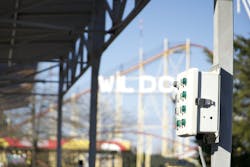Note: This article references the 2017 NEC because the Philadelphia area is still operating under that version of the Code.
Electricians power every industry within our modern economy — from the hospitality sector to the medical research industry to amusement and entertainment venues. Electricians are needed to power the motors, lighting, and controls in permanent amusement parks and mobile carnivals throughout the country. This article will provide a few tips and shortcuts on how to find the guidelines for installing portable wiring and equipment for carnivals, circuses, fairs, and similar functions. Use this handy guide for installing and repairing wiring in or on units designed to be moved (Portable Structures), as described in Sec. 525.2, which includes but is not limited to amusement rides, attractions, concessions, tents, trailers, trucks, and similar amusement structures/units.
The electrician’s duty
Your role as an electrician is to keep the “operator” safe; this is the individual responsible for starting, stopping, and controlling an amusement ride or supervising a concession. However, keep in mind the other parties you must keep safe. They include but are not limited to:
- Patrons/thrill seekers
- Park and event personnel
- City and county inspectors
- Teammates of the operator
Your role as an electrician is to prevent:
- Electrocution (death may occur)
- Electrical shocks (minor to major injuries)
- Preventable accidents (usually caused by the lack of maintenance)
- Equipment failure and malfunction (death or serious injury may occur)
Remember these guidelines first
- When the requirements of other articles in the Code and Art. 525 differ, the requirements of Art. 525 shall take precedence and be applied to all portable wiring and equipment, as noted in Sec. 525.3(A).
- Wiring in “Permanent Structures” shall apply to Art. 518 (Assembly Occupancies) and Art. 520 (Theaters, Audience Areas of Motion Picture and Television Studios, Performance Areas, and Similar Locations), as noted in Sec. 525.3(B).
- Article 640 shall apply to the wiring and installation of audio signal processing, amplification, and reproduction equipment that specifically covers these installations, as noted in Sec. 525.3(C). Read one of my past articles on Art. 640 here.
- Attractions utilizing pools, fountains, and similar installations with contained volumes of water shall be installed to comply with the applicable requirements of Art. 680 (Swimming Pools, Fountains, and Similar Installations), as noted in Sec. 525.3(D).
Keep ’em up high!
Wiring and conductors installed outside of tents and concessions shall have a vertical “overhead” clearance to ground in accordance with Sec. 225.18 (Clearance for Overhead Conductors and Cables) found in Chapter 2 (Wiring and Protection), as noted in Sec. 525.5(A). The clearance to ground for overhead conductors operating at 600V or less for portable structures shall be maintained not less than 15 ft in any direction [Sec. 525.5(B)(1)], except for the conductors supplying the portable structure. Portable structures included in Sec. 525.3(D) shall comply with Table 680.9(A) outlining overhead conductor clearances in swimming pools, fountains, and similar installations. Portable structures shall not be located under or within a space that is located 15 ft horizontally and extending vertically to grade of conductors operating more than 600V per Sec. 525.5(B)(2).
Protect all electrical equipment
Wiring methods and electrical equipment in or on units designed to be moved (portable structures) for tents, trucks, trailers, attractions, concession, and amusement rides shall be provided with mechanical protection where such equipment or wiring methods are subject to physical damage at (but not limited to) fairs, circuses, carnivals, and similar functions.
Follow the guidelines set in Art. 110 (Requirements for Electrical installations), which covers general requirements for the examination and approval, installation and use, access to, and spaces about electrical conductors and equipment; enclosures intended for personnel entry; and tunnel installations. It will explicitly guide you in the most important rules to follow.
Refer to Chapter 4 “Equipment for General Use” Table 400.4
Chapter 4 covers general requirements, applications, and construction specifications for flexible cords and flexible cables that are typically used for these installations. Use Table 400.4 (Flexible Cords and Flexible Cables) as your guide. For example, where flexible cords or cables are used, they shall be listed for extra-hard usage. Where flexible cords or cables are used and are not subject to physical damage, they shall be permitted to be listed for hard usage. Where used outdoors, flexible cords and cables shall also be listed for wet locations and shall be sunlight resistant. Extra-hard usage flexible cords or cables shall be permitted for use as permanent wiring on portable amusement rides and attractions where not subject to physical damage. Review Sec. 525.20 for more information.
A few more rules about wiring
- The minimum size single-conductor cable shall be size 2 AWG or larger [Sec. 525.20(B)].
- Per Sec. 525.20(C), open conductors shall be prohibited except as part of a listed assembly or festoon lighting installed in accordance with Art. 225.
- No cable splices! Flexible cords or cables shall be continuous without splice or tap between boxes or fittings [Sec. 525.20(D)].
- Cord connectors shall not be laid on the ground unless listed for wet locations. Connectors and cable connections shall not be placed in audience traffic paths or within areas accessible to the public unless guarded, as noted in Sec. 525.20(E).
- Wiring for an amusement ride, attraction, tent, or similar structure shall not be supported by any other ride or structure unless specifically designed for the purpose per Sec. 525.20(F).
- Per Sec. 525.20(G), flexible cords or cables accessible to the public shall be arranged to minimize the tripping hazard and shall be permitted to be covered with nonconductive matting, provided that the matting does not constitute a greater tripping hazard than the uncovered cables. It shall be permitted to bury cables. Note: The requirements of Sec. 300.5 shall not apply.
- A box or fitting shall be installed at each connection point, outlet, switch point, or junction point, as noted in Sec. 525.20(H).
A final note on the “disconnecting means” for rides, tents, and concessions
A means to disconnect each portable structure from all ungrounded conductors shall be provided. The disconnecting means shall be located “within sight of” (this is an Art. 100 definition) and within 6 ft of the operator’s station. The disconnecting means shall be “readily accessible” to the operator (also an Art. 100 definition), including when the ride is in operation. Where accessible to unqualified persons, the disconnecting means shall be lockable.
A shunt trip device that opens the fused disconnect or circuit breaker when a switch located in the ride operator’s console is closed shall be a permissible method of opening the circuit per Sec. 525.21 (A), which discusses disconnecting means.
Follow my column for more practical how-to articles and tips for applying electric basics concepts in the field. Past columns include Everyday Instructions for Electricians, The Apprentices Guide to Special Equipment, The Apprentice’s Intro Guide to Motors, The Apprentice’s Guide to Service Entrance Cable, The Apprentice’s Guide to NEC Art. 382, The Apprentice’s Guide to Article 625, The Apprentice’s Guide to NEC Art. 550 and The Apprentice’s Guide to Success in the Electrical Construction Industry. For more information on why a structured approach is so important to navigating the NEC and how to put its requirements into practice in real-world settings, read “The NEC for Newbies.”
Harold De Loach, a master electrician and electrical trainer/instructor, is the founder of The Academy of Industrial Arts (www.taia-school.com) in Philadelphia. With more than 30 years of experience in the field, he writes regular exclusive content for the E-Train and can be reached at [email protected].
About the Author
Harold De Loach
De Loach is the Director of Education and Training for the Leaders of Electrical License Preparation courses for Philadelphia and The Lehigh Valley (www.necprepclass.com). He is the founder and Director of The Academy of Industrial Arts L.L.C. (www.taia-school.com), a customized electrician training program that provides entry-level electrician training courses, electrical safety classes and customized electrical construction courses. He is trained by the National Center for Construction Education and Research (NCCER). He is a member of The National Society of Collegiate Scholars, the Independent Association of Electrical Inspectors, the Electrical Association of Philadelphia, and the Better Business Bureau.
His level of knowledge affords him to teach entry, intermediate, and master level electricians. Armed with more than 20 years of experience in the electrical, general construction, and real estate development industry, he offers his students and clients several unique skill sets. He has worked as the Head Craft Instructor and Assistant Director of Education at the Apprenticeship Training Center (affectionately known as The ABC School) in Harleysville Pennsylvania for Associated Builders and Contractors (The South-Eastern Pa. Chapter). Prior to Joining ABC, he directed a work-readiness (Re-Entry) Construction Technology program within The Philadelphia Prison System and as an Electrical Technician Program instructor at Kaplan Career Institute (Formerly Thompson institute) in Center City Philadelphia and Franklin Mills. He is available for consultation, private tutoring, speaking engagements, or strategic partnerships that can bolster the number of new electricians entering the industry.

